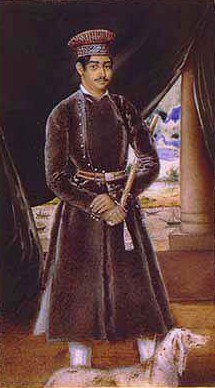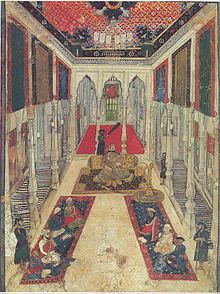
A zamindar in the Indian subcontinent was an autonomous or semi-autonomous feudal ruler of a zamindari. The term itself came into use during the reign of Mughals, Marathas and later the British had begun using it as a native synonym for "estate". The term means landowner in Persian. They were typically hereditary, and held the right to collect tax on behalf of imperial courts or for military purposes.
Reddy is a caste that originated in India, predominantly settled in Andhra Pradesh and Telangana. They are classified as a forward caste.
Deshmukh (IAST:Dēśamukh), is a historical title conferred to the rulers of a Dēśamukhi. It is used as a surname in certain regions of India, specifically in the states of Maharashtra, Karnataka, Telangana Andhra Pradesh and northern parts of Madhya Pradesh and Gujarat, Goa whose family received it as a title.

Ram Sharan Sharma was an Indian historian and Indologist who specialised in the history of Ancient and early Medieval India. He taught at Patna University and Delhi University (1973–85) and was visiting faculty at University of Toronto (1965–1966). He also was a senior fellow at the School of Oriental and African Studies, University of London. He was a University Grants Commission National Fellow (1958–81) and the president of Indian History Congress in 1975. It was during his tenure as the dean of Delhi University's History Department that major expansion of the department took place in the 1970s. The creation of most of the positions in the department were the results of his efforts. He was the founding Chairman of the Indian Council of Historical Research (ICHR) and a historian of international repute.
The Singranatore family is the consanguineous name given to a noble family in Rajshahi of landed aristocracy in erstwhile East Bengal and West Bengal that were prominent in the nineteenth century till the fall of the monarchy in India by Royal Assent in 1947 and subsequently abolished by the newly formed democratic Government of East Pakistan in 1950 by the State Acquisition Act.
Numbardar or Lambardar is a title in the Indian subcontinent which applies to powerful families of zamindars of the village revenue estate, a state-privileged status which is hereditary and has wide-ranging governmental powers share in it, the collaboration with the police for maintaining law and order in the village, and it comes with the associated social prestige. In contrast, the Zaildar who was the grand jagirdar and usually had the power over 40 to 100 villages. The Zail and Zaildar system of British Raj was abolished in 1952 in India but the lambardar system still continues in Pakistan and in some places in India.

Maa Bhoomi is a 1979 Indian Telugu-language social problem film directed by Goutam Ghose in his debut. The film is produced by B. Narsing Rao, who also wrote the film with Goutam Ghose. The film is based on the novel Jab Khet Jage by Krishan Chander on the Telangana Rebellion in Hyderabad State. It depicts a typical life of villagers under feudalistic society in the Telangana region. The film features Sai Chand, Rami Reddy and Telangana Shakuntala in pivotal roles. The plot follows Ramayya, a landless peasant who joins the Telangana Rebellion of 1948.

The Tekari Raj was a zamindari estate of the Bhumihar community in South Bihar. They controlled 2,046 villages on their estate, which covered a 7,500 square kilometres (2,900 sq mi) area, near to the town of Gaya.
Feudalism in contemporary Pakistan usually refers to the power and influence of large landowning families, particularly through very large estates and in more remote areas. The adjective "feudal" in the context of Pakistan has been used to mean "a relatively small group of politically active and powerful landowners." "Feudal attitude" refers to "a combination of arrogance and entitlement." According to the Pakistan Institute of Labor Education and Research (PILER), five percent of agricultural households in Pakistan own nearly two-thirds of Pakistan's farmland.

Komaram Bheem (1901–1940), alternatively Kumram Bheem, was a revolutionary leader in Hyderabad State of British India from the Gond tribes. Bheem, in association with other Gond leaders, led a protracted low intensity rebellion against the feudal Nizams of Hyderabad in the eastern part of the princely state during the 1930s, which contributed in the culmination of the Telangana Rebellion of 1946.

Ghughudanga Zamindar Bari was the residential palace and place of business of the Ghughu-danga zamindar family. It is situated on the banks of the Purnobhoba River in Dinajpur District. The palace was destroyed by Pakistani soldiers in the 1971 Bangladesh Liberation War.

The East Bengal State Acquisition and Tenancy Act of 1950 was a law passed by the newly formed democratic Government of East Bengal in the Dominion of Pakistan. The bill was drafted on 31 March 1948 during the early years of Pakistan and passed on 16 May 1951. Before passage of the legislature, landed revenue laws of Bengal consisted of the Permanent Settlement Regulations of 1793 and the Bengal Tenancy Act of 1885.

The Zamindars of Bengal were zamindars of the Bengal region of the Indian subcontinent. They governed an ancient system of land ownership.
Inukonda Thirumali, or Acharya Thirumali is an Indian historian, and was an activist for separate statehood for Telangana. He is the chairman of Joint Action Committee of Telangana, Praja Sanghalu.

Zamindars of Natore were influential aristocratic Bengali Zamindars, who owned large estates in what is today Natore District in Bangladesh .
Ajanbahu Jatbasha is considered by historians to be founder of the Gond dynasty of Chhindwara and Nagpur, which ruled the present days territories of Madhya Pradesh, Chhattisgarh and part of Maharashtra in the 16th-18th centuries. Documentation of his origins and rise to power have not survived, but he is the first historical leader of the mountain Gondi people.

The Zamindars of Bihar were the autonomous and semi-autonomous rulers and administrators of the Mughal subah of Bihar and later during British rule. The zamindars of Bihar were numerous and could be divided into small, medium and large depending on how much land they controlled. Within Bihar, the zamindars had both economic and military power. Each zamindari would have their own standing army which was typically composed of their own clansmen.
Ghatwali was a feudal tenure/jagir for quasi-military services, only found in the district of Santhal Parganas and some parts of Munger. The ruling chiefs of these jagir were known as Ghatwals. They were responsible for maintaining safety, security, and law enforcement in their estate using a force of archers and Berkandazes. The Deoghar subdivision consisted of 53 Ghatwalis among which the largest were Rohini, Pathrol, Baman-ganwa, Kukraha, Garsara, Teor and Burhe. The Deoghar ghatwali were formed under the Birbhum Raj in the 18th century to defend against the invasion of Marathas and neighbouring rulers. Kharna estate was another prominent ghatwali in Kharagpur Raj. The Kharagdiha gadis were earlier on ghatwali tenure, but when Captain Cammec found these Malik of the gadis prominent in their country, these gadis were permanently settled slowly after 1793. The ghatwals of Kharagdiha became the Zamindars and Rulers of their respective estates. Some of the prominent Khargdiha gadis were Gadi Palganj, Koderma, Goranjee, Gadi Ledo and Gadi Sirsia.

The Bhonsles of Nagpur were a Maratha royal house that ruled the Kingdom of Nagpur from 1739-1853. They hailed from the Bhonsle clan of Marathas and were one of the most important and powerful Maratha chiefs in the Maratha Empire.












